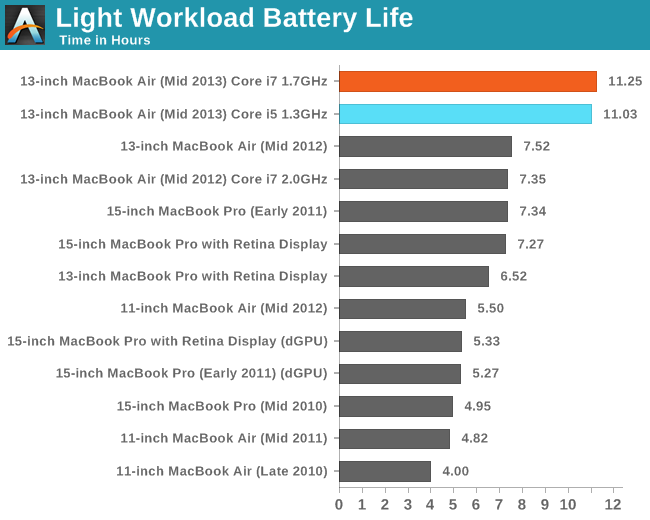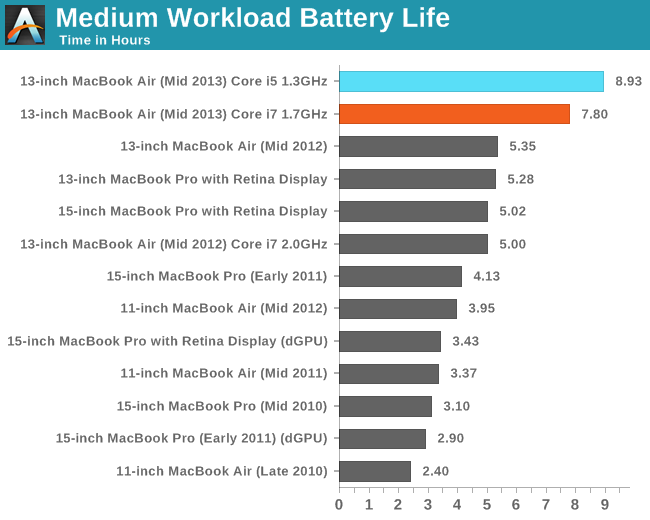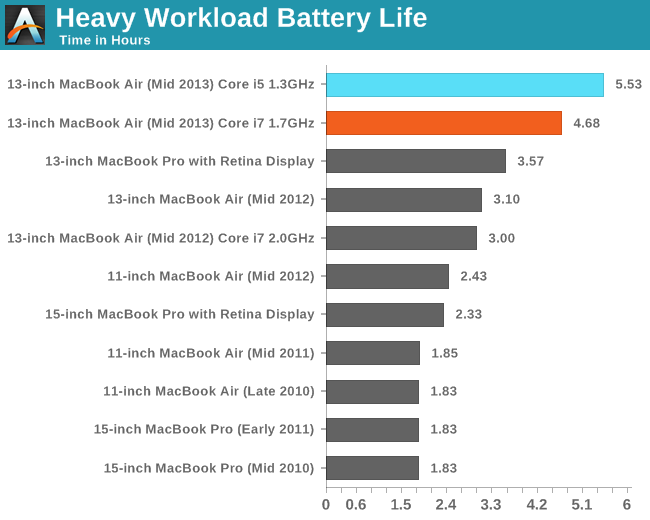The 2013 MacBook Air: Core i5-4250U vs. Core i7-4650U
by Anand Lal Shimpi on July 4, 2013 8:00 AM ESTBattery Life
I ran the i7-4650U based 13-inch MBA through the same suite of battery life tests as the un-upgraded base model. What's important to note about all of these tests is that the amount of work done per cycle of the test doesn't vary based on performance. There's enough idle time baked in to make sure that the Core i7 based 13-inch MBA isn't artifically penalized by having to do more work than the i5 model simply because it's faster. The other thing I noticed while testing these two machines is that although both were equipped with the exact same Samsung panel, their brightness curves were slightly different. At the same brightness setting under OS X (or Windows 8), both panels responded differently. Both were capable of similar max brightness values but it's clear that either Apple is doing some calibration here that's panel lot specific or there's a significant variance in how these panel/backlight/electronics combinations respond (or both).
I reproduced the battery life test details below:
The light and medium suites are inherently related - they use the same workload and simply vary the aggressiveness of that workload. The light test hits four different websites every minute, pausing for nearly the entire time to simulate reading time. Flash is enabled and present on three of the sites. The long pause time between page loads is what really makes this a light test. Web browsing may be the medium for the test but if all you’re doing is typing, watching Twitter update and maybe lazily doing some other content consumption this is a good representation of the battery life you’ll see. It’s a great way of estimating battery life if you’re going to be using your notebook as a glorified typewriter (likely a conservative estimate for that usage model).
The medium test hits the same webpages (Flash and all) but far more aggressively. Here there’s less than 10 seconds of reading time before going onto the next page. It sounds like a small change but the impact on battery life is tremendous.
Both the light and medium tests are run in their default state with processor graphics enabled, as well as with the discrete GPU forced on. I run with the dGPU on as well because it’s far too often that a single application open in the background will fire up the dGPU and contribute to draining your battery. The goal here is to deliver useful numbers after all.
The final test is very similar to our old heavy multitasking battery life tests, but with some updates. Here I’m downloading large files at a constant 1MB/s from a dedicated server, while playing back a looped 1080p H.264 movie (the Skyfall trailer) all while running the medium battery life test. The end result is a workload that gives you a good idea of what a heavy multitasking usage model will do in terms of battery life. I’ve found that OS X tends to fire up the dGPU anyway while running this workload so I saw no reason to run a separate set of numbers for processor and discrete graphics.

In our mostly idle workload, there's virtually no difference between the two parts in terms of battery life. The i7-4650U is actually able to boast a slightly higher number here but for all intents and purposes the two are equal. Apple's 12 hour estimate comes from a slightly lighter workload than what we run, so I see no reason that Apple couldn't claim equivalent max battery life regardless of what CPU option you pick.

Under load we begin to see the expected: the Core i7 upgrade does have a power cost associated with it. There's around a 13% reduction in battery life here compared to the standard 13-inch MBA configuration. Heavier workloads tend to force the CPU cores into higher frequency (and thus higher voltage) states. In the case of the i7 both the frequency and voltages are higher, which drives power consumption higher than the i5 resulting in lower battery life.

The gap between the i5 and i7 grows to its largest point in our heaviest workload, which makes sense. Here there's around an 18% reduction, or almost a full hour of battery life (52 minutes). If you ran both processors at full tilt nonstop (think looped Cinebench until both batteries die) you'd probably see an even larger gap. In this case I think the differences here are pretty reasonable expectations for most target usage models of the MacBook Air.
Thermals
As the MacBook Air isn't a handheld tablet, the limit for what's an acceptable max skin temperature is much higher. Just as there's an impact on battery life with the Core i7, there's also an impact on thermals. I ran a CPU and GPU intensive workload and measured thermals at three different points on the system: max temperature on the keyboard side of the system (upper left corner of the keyboard), max temperature on the bottom of the machine as well as the max temp reported by the CPU core proximity thermistor.
| 13-inch MacBook Air (Mid 2013) CPU Comparison - Observed Temperatures | ||||
| Location | Keyboard/Top | Bottom (sustained) | Bottom (max) | Internal CPU Proximity Thermistor |
| Intel Core i5-4250U | 47.1 °C | 41.4 °C | 41.4 °C | 92.2 °C |
| Intel Core i7-4650U | 47.7 °C | 42.1 °C | 46.6 °C | 96.7 °C |
Average temperatures aren't substantially higher on the i7, however you will notice that there's a column for max observed temperature on the bottom of the chassis where the upgraded MacBook Air does show a considerably higher temperature. The higher temp isn't sustained but I did record occasional blips up to 46.6 °C on the bottom of the chassis while the i5 model pretty much topped out at its sustained temperature. Internal temps are obviously much higher as well.
The impact on acoustics wasn't really noticeable. Under extended load both systems hit the same 6500 RPM fan speed, which given the same cooling system produced identical acoustic profiles. I tried to see if the i7 would ramp to 6500 RPM any quicker than the i5 but in most cases I don't believe it did, at least appreciably so.










127 Comments
View All Comments
FwFred - Saturday, July 6, 2013 - link
OP also called the MBA a coffee shop computer. While it certainly excels at this, it is in no way limited to this.KitsuneKnight - Friday, July 5, 2013 - link
Underpowered? I don't have the 2013 Air, but the base 13" 2011 model, and it's certainly not underpowered by any stretch of the imagination.It makes a wonderful development machine. I regularly run Xcode (+ iOS Simulator), Netbeans, and Visual Studio Premium 2012 (in a Windows 8 VM)*. None of which have a significant impact on battery life (even Visual Studio + Windows 8, which I definitely didn't expect), either. If you want a very light computer for software development, the Air is a wonderful machine.
The only things that actually "kills" battery life are OpenGL games (usually knocking it down to 2-3 hours, from 7). The machine DOES have a good enough GPU to play some indie titles like Minecraft and Kerbel Space Program comfortably, but I'd never recommend an Air as a gaming machine.
* In addition to any of those, I also always have open Safari, Chrome, Spotify, Skype, and iTerm 2 + SSH. Occasionally also Photoshop CS5 (I'm not an artist, though).
ASEdouard - Friday, July 5, 2013 - link
The 2013 Air surprised me as a, of course light, gaming machine. Granted it's not a new game, but I'm playing Starcraft 2 on high details at an excellent framerate. Pretty fun.KitsuneKnight - Saturday, July 6, 2013 - link
That reminds me, I actually have Starcraft 2 installed on this MBA. I have to run it fairly near the minimum settings (at the native resolution) to get decent (not amazing) framerates. If the new model is running SC2 at high with rather good FPS, then it's could probably comfortably play many more games than I'd have guessed.Of course, with how the typical Windows notebook is spec'ed, they'd likely be no better anyways (shipping garbage GPUs is something every OEM seems to loves to do).
ananduser - Saturday, July 6, 2013 - link
The budget shopper, you know, the one the OP made a reference to, has plenty of other better choices that provide more bang for the buck and less profit margin for Apple. The fanboy in you got way to defensive too fast without actually reading my previous post. The budget user won't spend 1000$ on a cramped machine(11") that needs adapters and expensive software licenses -VMWare/Parallels + Windows 8.I will make one concession - those better options are not as light and as portable as the 1000$ 11" MBA but they're still plenty portable.
KitsuneKnight - Saturday, July 6, 2013 - link
If you're wanting something that's super light and portable, the MacBook Air _IS_ the budget option. You would be very hard pressed to find a machine that trumps its portability and weight, for less (and if you do, you're probably making quite some sacrifices to get it... hell, even if you pay MORE than the Air you're likely getting a garbage trackpad).It's funny you say 'less profit margin', because the PC OEMs have continually failed to undercut Apple on the Air. They keep releasing worse machines that are more expensive... and they can only get as close as they've gotten thanks to Intel burning money to motivate them to compete. Apple might have good profit margins, but the consumer isn't paying any "Apple Tax" these days (Apple's process just blows the other OEMs out of the water, sadly enough).
>needs adapters
Adapters for what? I have 1 adapter for my Air, a mini-displayport to VGA cable ($20 on monoprice). I got it because I regularly need to use a projector (which most people will never use). And you know what? My machine has proven to be able to work the most reliably with any crappy projector thrown at it.
>and expensive software licenses -VMWare/Parallels + Windows 8.
You don't need that. If you do need to run some Windows software, for whatever reason, there's Wine, which works well with most software.
The reason I have Parallels + Windows 8 + VS2012 was because I needed to do development for the Windows Store, which is a rather rare use case. If I'd used VirtualBox instead of Parallels, I'd have actually spent $0 on the set up, but I'd rather pay a small amount of money for a much better experience, especially when said-experience results in monetary compensation.
ananduser - Saturday, July 6, 2013 - link
There are plenty ultraportables that undercut the AIR if undercutting is what you are aiming, so, technically, undercutting the AIR is possible. There will be some compromises but not to the extent that they'd be crap machines as you make them sound.Pretty much any ultraportable that is more expensive than the MBA is also better. I think the fanboy in you overreacted again. If Apple's process would've been so good they wouldn't have realeased a 1700$ rmbp that lags while browsing or a 1200$ PRO(?) machine with a 5400rpm drive and a 1280x800 TN screen.
Intel is paying OEMs for their own gains and not to compete with Apple. Apple refuses any other branding so it cannot tap into the marketing fund. The ultraportable segment is a niche one on any other OEM, because every one of them has broader lineups with more inexpensive gear that gets bought before people arrive at the ultraportable segment. Apple only sells 6 freaking laptop models, the first 2 and the cheapest of the bunch being the MBAs. You practically do not have any choice but to get the MBA for the cheapest entry in OSX land. People don't buy the MBA because it is a thin'n'light ultraportable; they buy it because it is the lowest price point in Apple's portable line up.
1000$ 11" ultraportables fit for midgets are definitely not budget. It's the budget Apple option for OSX users like you maybe.
PS:Oh and since this is a pretentious tech site, Apple has also achieved a first. The first next gen machine that is actually slower than the last gen, and in some cases even slower than the one before. Progress indeed.
shsu - Monday, July 15, 2013 - link
Hey kitsune, what is your average CPU usage running all that on your base model? Does it ever reach 100%? I have almost same use case: dev tools plus windows vm.ESC2000 - Monday, August 12, 2013 - link
$1,000+ for the base model is not affordable except to this with a lot of disposable income.More importantly, the air isn't a good value, mainly because apple slapped an unnecessarily high price on these as they do with every product, the so-called apple tax. Why does the air cost more than the VAIO even though the air has a crappy display and apple didn't have to pay for the OS license like Sony did? For people who care about affordability, value is really important. Lining apple's pockets doesn't give any value to the buyer.
iwod - Friday, July 5, 2013 - link
I have a few things in my mind which i couldn't grasp.Surely Apple would have know Samsung had a PCI-E SSD ready in around the same time frame. Why did apple choose to make their own PCI-E SSD and not just uses Samsung's one? I mean after all they both uses the same controller from Samsung.
Why did Apple decide to use 2x PCI-E 2.0 for its SSD instead of 4x like the one Samsung shown.
I am looking forward to next year's 14nm Broadwell MBA. Hopefully I wouldn't need a i7 then as the baseline should work just fine. Along with even better SSD and hopefully matured 802.11ac.